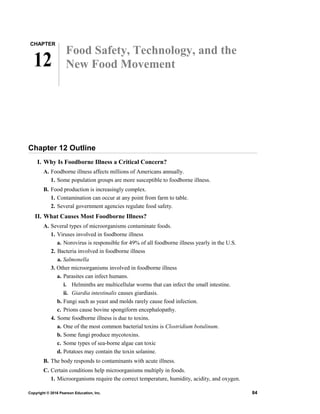
Chapter 12 lecture outline
- 1. CHAPTER 12 Food Safety, Technology, and the New Food Movement Chapter 12 Outline I. Why Is Foodborne Illness a Critical Concern? A. Foodborne illness affects millions of Americans annually. 1. Some population groups are more susceptible to foodborne illness. B. Food production is increasingly complex. 1. Contamination can occur at any point from farm to table. 2. Several government agencies regulate food safety. II. What Causes Most Foodborne Illness? A. Several types of microorganisms contaminate foods. 1. Viruses involved in foodborne illness a. Norovirus is responsible for 49% of all foodborne illness yearly in the U.S. 2. Bacteria involved in foodborne illness a. Salmonella 3. Other microorganisms involved in foodborne illness a. Parasites can infect humans. i. Helminths are multicellular worms that can infect the small intestine. ii. Giardia intestinalis causes giardiasis. b. Fungi such as yeast and molds rarely cause food infection. c. Prions cause bovine spongiform encephalopathy. 4. Some foodborne illness is due to toxins. a. One of the most common bacterial toxins is Clostridium botulinum. b. Some fungi produce mycotoxins. c. Some types of sea-borne algae can toxic d. Potatoes may contain the toxin solanine. B. The body responds to contaminants with acute illness. C. Certain conditions help microorganisms multiply in foods. 1. Microorganisms require the correct temperature, humidity, acidity, and oxygen. Copyright © 2016 Pearson Education, Inc. 84
- 2. III. How Can You Prevent Foodborne Illness? A. Clean: wash hands and surfaces often. B. Separate: don’t cross-contaminate. C. Chill: store foods in the refrigerator or freezer. 1. Purchase refrigerated and frozen foods last. 2. Check “sell by” or “best used by” dates on labels. 3. Do not purchase foods with damaged packaging. 4. Refrigerate perishable foods immediately after getting home. 5. Avoid keeping leftovers more than a few days. 6. Freezers should be maintained at 0º F. 7. Molds can grow on refrigerated foods. D. Cook: heat foods thoroughly. 1. Testing with a food thermometer is the only way to be sure a food is thoroughly cooked. 2. Many toxins are unaffected by heat. E. When eating out, take precautions to avoid foodborne illness. F. When traveling to other countries, select foods and beverages carefully. IV. How Is Food Spoilage Prevented? A. There are tried-and-true methods for preserving foods through natural techniques. 1. Salting, sugaring, drying, and smoking preserve food by drawing the water out of the cell. 2. Smoking does not guarantee food safety. 3. Cooling slows bacterial metabolism. B. Technical advances have improved food safety. 1. Industrial canning extends the average shelf life of food to at least two years. 2. Pasteurization significantly decreases the number of heat-sensitive microorganisms, which tend to be the most harmful. 3. Irradiation kills or disables microorganisms in food. 4. Aseptic packaging is the most environmentally sound packaging technique. 5. Modified atmosphere packaging involves replacing oxygen in a food package with an inert gas. 6. High-pressure processing inactivates most bacteria, but retains food quality. V. What Are Food Additives, and Are They Safe? A. Food additives include nutrients and preservatives. 1. Vitamins and minerals are added to foods as nutrients and preservatives. 2. Sulfites and nitrites are two preservatives that have raised health concerns. B. Other food additives include flavorings, colorings, and other agents. C. Are food additives safe? 1. The Delaney Clause prevents carcinogenic food additives. 2. The GRAS list identifies food additives. VI. How Is Genetic Modification Used in Food Production? 85 INSTRUCTOR MANUAL FOR NUTRITION FOR LIFE, 4/e Copyright © 2016 Pearson Education, Inc.
- 3. A. Recombinant DNA technology enables production of plants and animals which express desirable traits not present in the original organism. B. Genetically modified organism (GMO) refers to any organism that has altered DNA as a result of recombinant DNA technology. VII. How Do Residues Harm Our Food Supply? A. Persistent organic pollutants (POPs) can cause illness. 1. Mercury and lead are nerve toxins found in the environment. 2. Endocrine disruptors disturb hormonal functions a. Chemicals from plastic food containers that can leach into the foods they hold. b. Dioxins are industrial pollutants formed as a result of combustion. B. Pesticides protect against crop losses – but at a cost. 1. There are three types of pesticides. a. Herbicides are used to control weeds and other unwanted growth. b. Insecticides are used to control insects that can infest crops. c. Fungicides are used to control plant-destroying fungal growth. 2. Pesticides can be natural or synthetic. a. Biopesticides are natural pesticides that work to reduce pest populations. b. Synthetic pesticides are often made from petroleum-based products. 3. Pesticides are potential toxins. 4. Government regulations control the use of pesticides. C. Growth hormones and antibiotics are used in animals. 1. Recombinant bovine growth hormone (rBGH) induces beef cattle to grow more muscle tissue and dairy cows to increase milk output. 2. Antibiotics are used in many animals to control disease. D. Organic agriculture reduces residues 1. Organic describes crops that are grown without the use of synthetic fertilizers, toxic and persistent pesticides, genetic engineering, or irradiation. 2. Standards for organic labeling. 3. Benefits and costs of organic foods. VIII. What’s Behind the Rising Food Movement? A. Sustainable agriculture preserves natural resources. B. Food diversity supports a healthful diet. C. Several initiatives promote sustainability and diversity. D. Food equity promotes a fair sharing of resources. 1. Food insecurity and the inability to obtain adequate food. 2. Fair trade against exploitation of farm workers. E. Your actions can promote sustainability, diversity, and food equity. Copyright © 2016 Pearson Education, Inc. CHAPTER 12 Food Safety, Technology, and the New Food Movement 86
